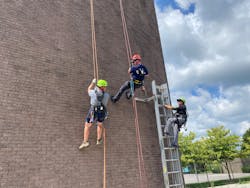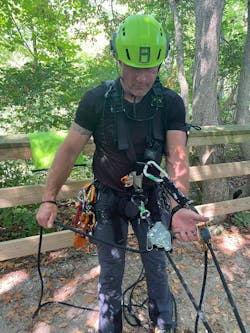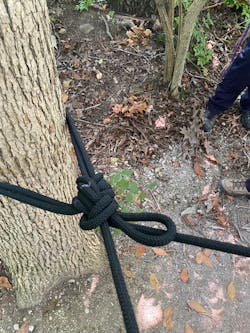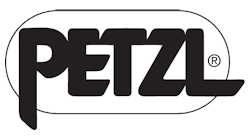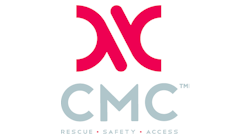For every organization, continually evaluating mission and purpose is imperative. It’s easy to get off track or diluted in staying true to your primary objective. When it comes to rope rescue, there’s an alarming trend in the fire service to move away from quick and efficient early access to victims and progress toward the more resource-intensive system-based approach.
Should rappelling and ascending rope be replaced with fixed-brake systems? What about tactical overview for scene assignments? The technical skills that are required for quick-access operations?
What is the mission?
Why are so many fire departments wary of personal rope access concepts and so receptive to team-based tactics? Based on conversations with many groups, they seem to perceive that there’s more risk involved with rappelling and ascending; that team-based systems can be overseen more effectively by safety officers and team leaders; and that there’s less potential for technical error with team-based systems than when a single rescuer deploys independently to the victim and is entirely responsible for the operation and techniques while on rope. I believe that the best answers can be found when we return to the question: What is the mission?
The mission is to save lives. In almost all circumstances, the likelihood of a successful rescue mission is increased exponentially when we gain early access to the victim(s). This allows rapid assessment and intervention as well as refinement of rescue plans and resource requirements. Early access to victims almost always is accomplished more quickly with individual rescuers who deploy independent of major system support. It can be done responsibly, safely and with no increased risk factor, provided that proper training and equipment are in place. This doesn’t negate the importance of team-based systems to be put in place to affect the rescue if needed. It simply complements team systems to get the event running in the right direction.
The other option—err on the side of simplicity, management and super-safety and not deploy rescuers who aren’t on fixed lower/haul systems—delays access and care for the victim, resource recognition, rescue plan refinement, and packaging and extraction. This approach loses sight of the mission. Rather than a mission of saving lives, this mission is something like, “Let’s do rescue things in a really safe and managerial-heavy fashion first and foremost, with the hope of rescuing someone.”
The working groups
How can the two worlds be brought together and a safe and practical approach be developed? We advocate the following sectors/working groups.
Command, Safety, Recon. These are the responsibilities of the first-due rescue group. This might be one highly trained company or a collaborative effort of individuals from multiple apparatus who are qualified to perform these skills. Command and safety focus on interviewing witnesses, evaluating the environment and developing a hazard-management plan (safety officer) and a rescue plan (incident or operational command). The recon team is the quick-access team, the primary and hyper-focused mission for which is to rappel or ascend to the victim when appropriate with basic EMS resources. When gaining direct access isn’t appropriate, the recon team focuses on remote assessment and on communicating findings with command.
Hazard Management. The second-due rescue group reports to the safety officer and develops the necessary infrastructure for safe operations early in the incident. This usually looks like edge tend line or fall protection, Hot Zone and Cold Zone identification and management of additional hazards or obstacles, which can be environmental, atmospheric or physical. For example, in natural terrain, this group could clear brush and small trees to accommodate high-directional anchors or rigging lanes. Industrial settings might require lockout/tagout operations, air monitoring and ventilation procedures.
Support. This group reports to command and is responsible for carrying out all of the rigging for the rescue system. Its first priority is to get any additional resources that are required for victim packaging to the recon team. It then can shift its attention to the lower/haul systems and safety components that are required.
Rescue. Now that everything is ready to rock, the rescuers can execute the rescue plan. Additional rescuers might be required at the victim spot (top side or bottom side) for more lateral-based systems, tag lines, advanced victim packaging, victim tending, etc. If this is the case, they can deploy on the same access lines that were established by the recon team while the system-based rescue lines still are being developed. The additional rescuers typically fill the final operational roles of squad or group leaders and edge tenders.
The recon team should approach the scene fully equipped and ready to roll. Team members should have on all of their PPE, and their harnesses should be set up properly for rappelling and ascending rope. This doesn’t mean that they must have chest ascenders and foot ascenders and be trained in rope walking. What is reasonable is to have a descent-control device (DCD) that has the versatility to support both up and down movement. (CMC Clutches and Petzl IDs are the prevalent devices.) Optimally, you also need a handle ascender that has a built-in pulley or a small carabiner that has a built-in pulley that’s connected to a standard handle ascender. (Less optimal would be a handle ascender that has a carabiner and separate pulley. Even less efficient to the operation is a different rope grab, such as a Prusik, that’s connected to a pulley.)
Additional gear requirements include a dynamic belay device, such as an ASAP lock, and a rope bag that’s slightly more than double the distance of the necessary access to the victim. Standard additional personal resources on your harness are encouraged: carabiners, rope grabs, slings. If you have immediate access to a sked or a small packaging kit that can be worn as a lightweight backpack, it doesn’t hurt to grab that for the operation as well.
Ideally, the recon group is at minimum a two-person team. This allows for redundant safety checks, cooperative rigging and victim care/packaging. (I performed this responsibility several times as an individual. It requires more personal scrutiny, which always slows me down.)
Establish an anchor
As the team approaches the working edge, determine whether fall protection and a safety line are needed to access the edge. If so, establish an anchor at an appropriate distance to support the edge transition. Often, this is the most challenging part of access, because this little distance from anchor point to edge might add edge protection requirements. Remember, you are packed out as minimalists to some degree, so creative rigging might be required.
There are dozens of ways to rig access lines and deploy to the victim, but a versatile application for this approach is:
Split your rope in half by playing out both tails of the rope and finding the midpoint. (This can be pre-staged.) Store some of your rope bags in this fashion, with both tails at the top of the bag. Using the bight of the middle of the rope, tie a bowline around the anchor with a Yosemite knot on a bight finish (see sidebar below).
You now have two sections of rope that exit the bowline as well as a Yosemite bight that could function as an attachment point for additional gear.
Place edge protection as warranted by the circumstances. Remember, these are fixed lines, so the edge pro can be rather isolated and specific to a particular hazard or aggressive edge interaction.
You’re ready to deploy over the edge. Having the ascending resources allows you the flexibility to navigate independent of the rescue-based systems to position yourself midwall and help vector lines or place additional edge pro. You also can independently tend to the victim while that individual is hauled up, which puts less load on the rescue system and creates better redundancy for the operation.
The second recon rescuer can deploy immediately after you are on the deck or can rig recon lines as well. The second recon rescuer also can lower victim care and packaging equipment as soon as the primary is bottom side, so care and packaging are initiated as soon as possible.
When you are ready to ascend for the rescue, you can rig a rapid ascent/descent (RAD) system. The system is rigged by taking the handling end of the rope coming out of your DCD and directing it through the pulley on your handle ascender. The handle ascender is placed on the mainline above your DCD. This results in a 3:1 mechanical advantage when you initiate the pull as the rescuer on rope. When you close the distance between the ascender and the DCD, you simply advance the handle ascender and do it again.
Check the data
If you are a proponent of the team-based fixed lower/haul concept, vet your tactics. Run time trials with independent recon access versus waiting for an elaborate lower/haul system to be developed.
If you develop quick-recon lower/haul systems that are fixed and managed by personnel in main and Belay configuration or mirrored configuration, consider the limitations in versatility when rescuers encounter obstacles and problems on the way down or on the bottom side. Evaluate the amount of resources that were required to help them to solve those problems versus having flexible capabilities that are built into one- and two-recon rescuers.
Tying a Yosemite Knot
A way to rig access lines that works in almost every scenario involves tying a bowline around an anchor with a Yosemite knot on a bight finish. A Yosemite knot is tied in the following fashion:
- Facing the anchor with the load path behind you, pass the bight around the anchor from left to right
- Using both segments of rope on the left side, create a round turn and pull up a double slip knot from the running tail side of the round turn
- Bring the bight to your chest and push it through the bight of the slip knot and bring it back onto itself, squeezing all four sections of rope
- Grab the running tails of the slip knot and collapse it, allowing the bowline to form as it pops through
- Trace the round turn with the middle bight and exit the bowline to form the Yosemite on a bight element
Dalan Zartman
Dalan Zartman is a 20-plus-year career firefighter who is assigned to a heavy rescue in Ohio. He is a rescue instructor, a certified Firefighter II and rescue specialist, a public safety diver and a paramedic. Zartman is president and founder of Rescue Methods LLC, which is an international training and consulting group that provides technical rescue training/consulting and alternative energy research, training and testing under the auspices of Bowling Green State University. You can reach him at [email protected].
